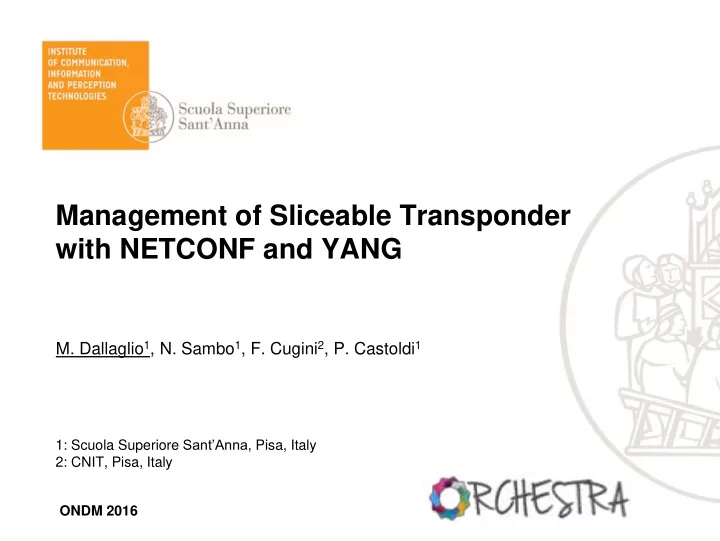

Management of Sliceable Transponder with NETCONF and YANG M. Dallaglio 1 , N. Sambo 1 , F. Cugini 2 , P. Castoldi 1 1: Scuola Superiore Sant’Anna , Pisa, Italy 2: CNIT, Pisa, Italy ONDM 2016
Introduction • Relevant advances in the data and control plane - data plane: ✓ flexible transponders configurable/adaptable rate, FEC, format, slice- ability … ✓ support of monitoring through Digital Signal Processing (pre-FEC BER, Q factor, etc.) - control plane: ✓ Software Defined Networking to remotely set network devices, programming transmission characteristics (such as bit rate) and switching • Management? - innovations have not followed these trends yet [1]: ‣ issues related to the presence of network devices from different vendors ‣ lack of standard solutions (e.g., for operation administration and maintainance – OAM) • NETCONF based on YANG model is emerging as a standard SDN protocol providing both control (e.g., data plane device configuration) and management (e.g., access to monitoring information) functionalities In this paper: • we present and demonstrate a YANG model describing flexible transponders supporting monitoring functionalities • experimental demonstration: connection setup and OAM through NETCONF and YANG [1] A. Martinez, M. Yannuzzi, V. Lopez, D. Lopez, W. Ramirez, R. Serral-Gracia, X. Masip-Bruin, M. Maciejewski, and J. Altmann , “Network management challenges and trends in multi-layer and multi-vendor settings for carrier- grade networks,” Communications Surveys Tutorials, IEEE , vol. 16, no. 4, 2014.
NETCONF and YANG • NETCONF: Network configuration and management protocol standardized by IETF [2] − Clear separation between configuration and state data − Possibility to create and modify configuration data − Possibility to retrieve state data and to be notified once particular events occur • YANG: data modelling language can be used to describe the structure and semantics of a network device in a vendor-neutral format [3] − Ongoing work on YANG model for flexigrid TED (with some transponder information) [4] [2] R. Enns, M. Bjorklund, J. Schoenwaelder, and A. Bierman , “Network configuration protocol (NETCONF),” IETF RFC 6241, June 2011. [3] M. Bjorklund , “YANG - a data modeling language for the network configuration protocol (NETCONF),” IETF RFC 6020. [4] 1. J. Vergara and et al., IETF draft-vergara-ccamp-flexigrid-yang-02, Oct. 2014.
NETCONF messages Controller Device NETCONF Client NETCONF Server DISCOVERY (supported YANG models) RUNNING CONFIGURATION + STATE (Functionalities) DEVICE CONFIGURATION PARAMETERS MONITORING
Reference sliceable transponder (S-BVT) S-BVT (add/drop ports) Optical coupler/ Sub-carrier module #1 OXC mux Sub-carrier module #2 Sub-carrier module #k Sub-carrier module TX side MOD DSP DAC PM COH DSP ADC RX RX side N . Sambo and et al., “Next generation sliceable bandwidth variable transponders,” Communications Magazine, IEEE, vol. 53, no. 2, pp. 163 – 171, Feb 2015.
TRANSPONDER YANG SCHEME Following : YANG standardization guidelines IETF [5,6] and OpenConfig working group [7]. We propose: TRANSPONDER NODE INFORMATION NOTIFICATIONS SLICE-ABILITY SUPPORT N M 2 2 SUB-CARRIER CONNECTION 1 MODULE 1 [5] A. Bierman , “Guidelines for Authors and Reviewers of YANG Data Model Documents”, IETF RFC 6087, 2011. [6] R. Shakir , “Consistent Modeling of Operational State Data in YANG draft -openconfig-netmod-opstate- 01”, IETF Draft, 2015. [7] http://www.openconfig.net
YANG CONFIG AND STATE DATA Configuration data • Writable (NETCONF <edit-config>) • Explicitly set by an external entity State data • Read only (NETCONF <get>) • Parameters that cannot be set by an external entity • Monitoring information / parameters supported by the device Intended configuration: the state that the network operator intends the system to be in. Applied configuration: the state that the network element is actually in. Configuration data is replicated into State data
SUB-CARRIER MODULE SUB-CARRIER MODULE CONFIG STATE Sub-carrier ID Sub-carrier ID Supported Bit-Rates Bit-rate Bit-rate Baud-rate Baud-rate Supported Baud-Rates Modulation Modulation FEC FEC Supported Modulations Central Central Frequency Frequency Supported FECs Bandwidth Bandwidth Direction Direction TRANSMITTER RECEIVER RECEIVER TRANSMITTER Output Power Local Oscillator Local Oscillator Output Power Sampling Rate Sampling Rate Analog BW Analog BW Input Power Pre-FEC BER Sample Variance PMD CD Q-Factor
CONNECTION MODULE CONNECTION MODULE CONFIG STATE Connection ID Connection ID Transmission Scheme Transmission Scheme Frequency Slot Frequency Slot m m n n List of Sub-carrier IDs List of Sub-carrier IDs
Experimental demonstration TESTBED DEVICE CONTROLLER Python NETCONF Client C program emulating the DEVICE ConfD API TCP Socket ConfD DB (NETCONF Server) IP Switch • Transponder Discovery • Connection Setup • Connection Monitoring
Transponder discovery <rpc-reply> message <?xml version="1.0" encoding="UTF-8" ?> The controller issues a <get> message to <rpc-reply xmlns="urn:ietf:params:xml:ns:netconf:base:1.0" message-id="1"> retrieve the device’s current state <data> <transponder xmlns="http://sssup.it/transponder"> <node-id>1</node-id> (e.g. installed sub-carriers modules, supported <add-drop-id>1</add-drop-id> <slice-ability-support>true</slice-ability-support> transmission parameters). <subcarrier-module> <subcarrier-id>1</subcarrier-id> <state> <supported-bit-rates> <get> <bit-rate>112.0</bit-rate> <bit-rate>124.0</bit-rate> <bit-rate>224.0</bit-rate> <rpc-reply> <bit-rate>248.0</bit-rate> Controller Device </supported-bit-rates> <supported-baud-rates> <baud-rate>28.0</baud-rate> Wireshark Capture <baud-rate>31.0</baud-rate> </supported-baud-rates> <supported-modulations> <modulation xmlns:mdfrms="/sssup/mdfrms">mdfrms:dp-qpsk</modulation> <modulation xmlns:mdfrms="/sssup/mdfrms">mdfrms:dp-16qam</modulation> </supported-modulations> <supported-fec> <fec xmlns:fec="/sssup/fec-types">fec:ldpc</fec> <fec xmlns:fec="/sssup/fec-types">fec:golay</fec> </supported-fec> </state> </subcarrier-module> <get> message ......... <subcarrier-module> <?xml version="1.0" encoding="UTF-8" ?> <subcarrier-id>4</subcarrier-id> <rpc xmlns="urn:ietf:params:xml:ns:netconf:base:1.0" message-id="1"> ......... <get><filter type='xpath' select=' /transponder' /></get> </subcarrier-module> </rpc> <connections></connections> </transponder> </data> </rpc-reply>
Connection Setup <edit-config> message <?xml version="1.0" encoding="UTF-8"?> The controller issues a <edit- <rpc xmlns=" urn:ietf:params:xml:ns:netconf:base:1.0“ message -id="1"> <edit-config xmlns:nc='urn:ietf:params:xml:ns:netconf:base:1.0'> config> message to create a <target><running/></target><config> <transponder xmlns="http://sssup.it/transponder" xmlns:nc="urn:ietf:params:xml:ns:netconf:base:1.0"> new connection. <subcarrier-module> <subcarrier-id>1</subcarrier-id> <config> <direction>RX</direction> Connection parameters: <bit-rate>112</bit-rate> <baud-rate>28</baud-rate> - 112Gbps <modulation xmlns:mf="/sssup/mdfrms">mf:dp-qpsk</modulation> <fec-in-use> - DP-QPSK <name xmlns:fec="/sssup/fec-types">fec:ldpc</name> - LDPC 14/15 FEC <rate> <message-length>14</message-length> <block-length>15</block-length> </rate> </fec-in-use> <central-frequency>193100</central-frequency> <bandwidth>33.6</bandwidth> <receiver> <sampling-rate>35</sampling-rate> <edit-config> <local-oscillator>193100</local-oscillator> <analog-bw>10.0</analog-bw> </receiver> </config> <rpc-reply> </subcarrier-module> Controller Device <connections> <connection nc:operation="create"> <connection-id>1</connection-id> <config> <connection-id>1</connection-id> <transmission-scheme>NWDM</transmission-scheme> <subcarrier> <subcarrier-id>1</subcarrier-id> </subcarrier> <rpc-reply> message <frequency-slot> <n>0</n> <m>3</m> </frequency-slot> </config> <?xml version="1.0" encoding="UTF-8"?> </connection> <rpc-reply xmlns="urn:ietf:params:xml:ns:netconf:base:1.0" message-id="1"> </connections> <ok/> </transponder> </rpc-reply> </config></edit-config> </rpc>
Recommend
More recommend